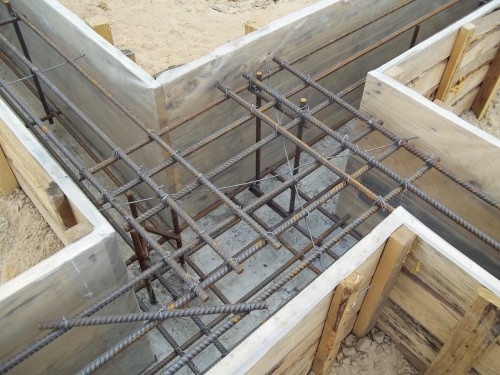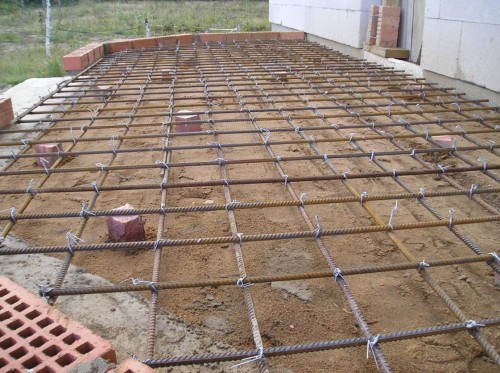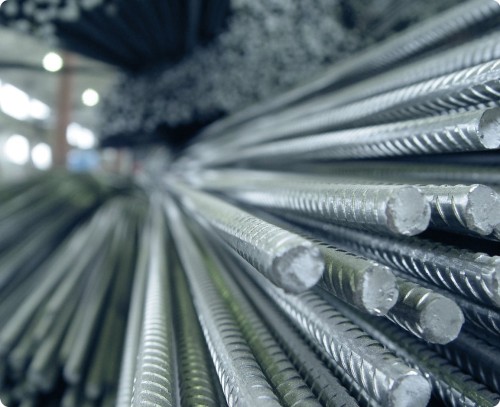Despite the overall strength, the foundation is distinguished by high fragility. Of course, with a proper approach, the strength of the foundation turns out to be quite acceptable, but for this you need to hold a number of building events. Obviously, we are talking about sufficient attachment, as well as other processes that significantly expand the boundaries of the operational capabilities of the structure.
Content
It should be borne in mind that the foundation has a huge amount of forces, due to which various problems arise. It is worth understanding that these forces include the effect of moisture, and frosty radiation. In addition, the strength of the walls, as well as the roof, cannot be excluded. It is only a small part of whether it can create a dangerous situation in the operation of the structure.
Ultimately, to avoid cracks and various deformations of the foundation, a protective layer of the foundation should be created, which consists of fittings or other materials. In this article we will try to disassemble the main points associated with the creation of the protective layer of the foundation. It is necessary to note in advance that this issue may have a lot of features, and it depends directly from the scale of construction, as well as from the fundamental funds used.
Basic forces acting on the basis
As we have already spoken, the foundation has a huge number of forces negatively affecting its strength. In such a situation you need to know about all factors, as well as take into account the level of their influence.
- Underground forces. These forces, as we have said, include frosty powder forces, water. Especially serious influences are groundwater, which for a certain amount of time can lead the foundation into the deplorable state. Of course, in most cases, such a base will not be subject to restoration. To avoid this, it is necessary to qualitatively carry out the waterproofing of the base, as well as do everything possible so that the moisture can affect the foundation.
- Exterior forces. The wall load has a tremendous value, and it must be taken into account in the project itself. The problem is often that the owners, for some period of operation, create certain extensions, and ultimately we get the reloading of the base. If the foundation cannot withstand the loads, it will begin to deform, after which the deformation of the main structure will occur. It is impossible to exclude and really dangerous emergencies.
Thus, to compensate for all the above forces, it is necessary to use fittings, which often copes even with colossal loads. Armature is a metal rod with a ribbed surface. The grip of such material with concrete is excellent, so it is so actively and used in any kind of construction. Moreover, massive metal structures are most often created, which take on all pressure.
As for the size of the reinforcement, the thickness of the metal products is limited to 16 mm, but under certain conditions it is possible to use particularly large fittings - a diameter of up to 32 mm.
For the transverse connection, thin fittings are often used, the diameter of which is 8 mm. It should be borne in mind that there is practically no pressure on the transverse reinforcement.
If we talk about the vertical fixation of the metal frame of the foundation, you can use various trimming here. The main thing is that these design elements retain the frame during the fill of concrete.
Features of fittings technology
Obviously, the framework of the reinforcement is the main strengthening of the existing design, therefore, it is necessary to refer to its state with a maximum responsibility. Thus, experts recommend avoiding any reinforcement contact with soil or water. If the moisture begins to affect the metal, then the corrosion process will begin, to resist which is almost impossible.
There are rules that need to be adhere to when creating a design from fittings:
- The upper reinforcement belt should be located 3-5 cm below the concrete layer. Accordingly, it will be enough to protect the metal products. In addition, even if water and will actively influence the foundation, the reinforcement will continue to be under reliable protection of concrete.
- The correct location of the bottom belt of reinforcement. This element of the design should be placed too close to the bottom of the trench. Most often, as already mentioned, vertical supports are used, which hold the framework. In addition, bricks that lift the reinforcement over the sand pillow can be used to hold the design.
- Corners of the frame. In this case, the situation is practically no different from what we have in past items. The valve must be positioned in such a way that there is about 5 cm from the surface of the angle to the metal.
If all the above conditions do not manage to observe, it is necessary to protect the foundation from the likely influence of moisture or soil. For this, as already mentioned, high-quality waterproofing is used. In large construction, it is impossible to allow mistakes, since a massive structure may be under threat.
Again, the most important thing is to avoid corrosion actions, since the reinforcement actually quickly loses its strength, and ultimately have more global problems.
Legislative standards and reinforcement of concrete
As you know, there are construction standards that simply need to adhere to the construction process. Thanks to existing standards, it is possible to determine how all construction activities need to be carried out. For example, in 2003, the main purpose of creating a protective layer of the foundation is indicated:
- The preservation of the foundation from the effects of the aggressive environment.
- The connection of the elements of the metal frame.
- Joint work of concrete and reinforcement.
In addition, the standards indicate the direct dimensions of the fortified foundation, as well as the size of the protective base layer.
Separately, I would like to note the method of calculating the minimum thickness of the reinforcement used to strengthen the foundation.
- The thickness of the protective should be at least 20 mm, but this is only if the design is used in closed rooms, as well as at a normal humidity level (and under reduced). Experts should be assessing the level of humidity.
- A 25 mm layer is created in the event that there is an increased humidity, and there is no additional protective agents.
- When it comes to a 30 mm layer, it must be borne in mind that such a design is located outdoors. Most often these are bearing walls.
- If the designs are immersed in groundwater, the thickness of the protective layer must be at least 40 mm.
If we are talking about prefabricated structures, then the thickness of the protective layer can be reduced to 5 mm. Of course, it will additionally will not prevent consultation with specialists, since everything can depend on several factors that for a person without experience can be insignificant.
In addition, there is an unwritten rule, in which the thickness of the protective layer should not be less than the diameter of the reinforcement itself.
If you analyze all the data associated with the defensive layer of the foundation, the following information will be obtained:
- The protective layer is 20 mm - for interior, for the manufacture of paving slabs and similar products.
- The protective layer is 50-70 mm - when assembling the frame in the monolithic foundation.
- The protective layer is 50 mm - when assembling a concrete scene.
Also, do not forget about the reinforcement of the concrete part of the floor, the breakfast around the buildings poured by the concrete sections of overlaps. In such conditions, the height of the incidence should be not more than 120 mm.
In the event that concrete reinforcement over 200 mm, it is necessary to use spatial structures. For raising frames, plastic or metal holders often use plastic or metal holders. They are distinguished by a high level of convenience. In addition, the holders fix the elements of the concrete structure as accurately as possible, and if necessary, you can evenly remove them from the surface of the concrete. In such situations, it certainly does not prevent the help of specialists who will install all the necessary elements as accurately as possible.
Tools and materials for creating a frame
Despite the fact that the foundation metal frame is a fairly simple design, it must be borne in mind that in this matter we will need quite a few tools and other devices. Most often these are the following tools:
- Bulgarian. Obviously, the reinforcement has one or another size, and to create a frame you need to customize the dimensions. Accordingly, Bulgarian in this case is an indispensable tool.
- Water level. This device is used in almost any building events. With it, it is possible to determine even the most minor deviations from horizontality or verticality.
- Roulette.
- Clamps. They are necessary in order to securely and evenly fasten the metal frame. In modern construction, this is an indispensable thing.
- Wire. With the help of wire, it is also possible to mount a metal frame, but in this case we are talking about the connection of individual structural elements. Pasal or welding are often used for reliable wire twisting.
If we are talking directly about creating a metal frame for the foundation, then the location of the reinforcement should be paid. It is the uniform installation of metal products that allows you to ensure maximum protection of the foundation from external influences.
Characteristics of concrete
In addition, it is necessary to take care of the protective layer of the foundation, and some characteristics of concrete should be analyzed. It is obvious that when building small private structures, the hosts are not too seriously related to the quality of this material, but this is a very important aspect to which it clearly should be paid attention to. It is important to draw attention to the fact that when creating a concrete mixture, it is necessary to take into account the proportions on which the consistency depends on. Ultimately, if the created mixture meets the requirements, the protective layer of the foundation may have sufficiently modest dimensions.
If the concrete turns out to be poorly, it will gradually collapse, and then the water (or any other external factor) will have full access to metal reinforcement. Such situations in construction occurs simply a colossal amount, so it should be analyzed in advance and make the right conclusions.
You should also regularly monitor the status of the foundation. Even if the quality of concrete turned out to be quite low, there is a good chance to keep the base in sufficient condition for safe operation. Thus, if you regularly examine the foundation, then some negative processes will be unambiguously noticeable. Most often it is a gradual deformation and fracture formation. If the process has begun and do not take anything on time, then the reinforcement will be at risk very soon. To avoid this, you should immediately eliminate all deformations. To do this, you can apply a cement mixture. In addition, it is necessary to create a waterproofing layer. Due to the action of moisture or water, we get a huge number of problems. Fortunately, on sale you can find a colossal amount of waterproofing means, with which you can be sure that due to the action of the water, the foundation will not collapse. If we have a high level of groundwater, the waterproofing, most often, will be in disrepair rather quickly, therefore, it should be regularly monitored for the condition of the created layer and if necessary to change it to a new one.























